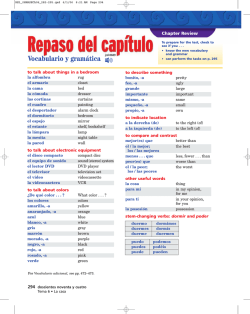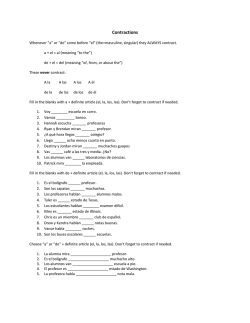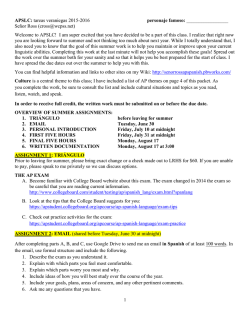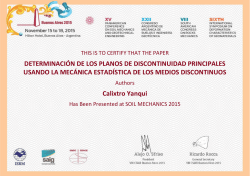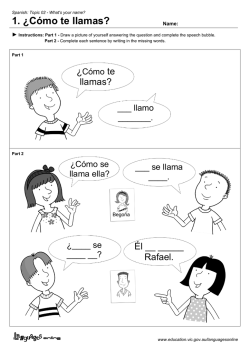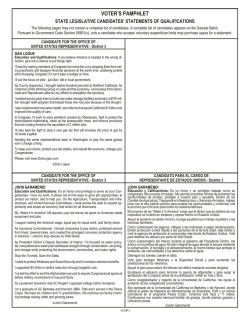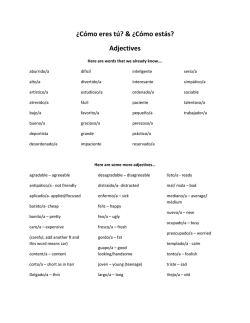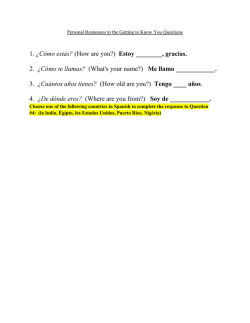
2015-16 AP Spanish Language and Culture
AP® Spanish Language and Culture Course and Exam ® AP Spanish Language and Culture . . . ► Aligns with the National Standards ► Reflects best practices at the college level ► Supports awarding of college credit and placement ► Prepares students for success in subsequent college/university courses 2 Goals of AP® Spanish Language and Culture ► Enhance student performance in the three modes of communication: ► Interpersonal ► Interpretive ► Presentational ► Engage ► Provide students in making cultural connections students with opportunities to further develop their language skills 3 Course Sequence & Curriculum Framework 4 ► AP® is generally the capstone course offered in the fourth or fifth year of an articulated sequence. ► The curriculum framework can be used to inform the entire program of instruction from the beginning to AP. The Curriculum Framework The Curriculum Framework provides information on… ► How to develop students’ proficiencies in each of the three modes of communication ► Expected levels of performance for each learning objective ► How to design thematic instruction ► How to unify instruction in classes that have students with combined levels ► Developing activities that focus on same theme and mode ► Differentiating instruction 5 Scope of the Course The AP® Spanish Language and Culture course: 6 ► Integrates language, content and culture ► Helps students “function in the language” rather than “learn language function” ► Promotes fluency and accuracy in language use, recognizing the importance of language structures, but placing priority on communication Focus on Communication The course is designed around an overarching premise: When communicating, AP® world language students demonstrate an understanding of the culture(s), incorporate interdisciplinary topics (Connections), make comparisons between the native language and the target language and between cultures (Comparisons), and use the target language in real-life settings (Communities). 7 The Three Modes of Communication 8 ► Interpersonal Communication ► Active negotiation of meaning among individuals through conversation (face-to-face or telephonic); or through reading and writing (e.g., exchange of personal letters, notes, or e-mails or participation in written online discussions) ► Interpretive Communication ► No active negotiation of meaning with another individual, although there is an active negotiation of meaning construction; includes the cultural interpretation of text, movies, radio, television, and speeches ► Presentational Communication ► Creation of spoken or written communication prepared for an audience and rehearsed, revised or edited before presentation; one-way communication that requires interpretation by others without negotiation of meaning Learning Objectives ► Spoken ► Written Interpersonal Communication Interpersonal Communication ► Audio, Visual, and Audiovisual Interpretive Communication ► Written ► Spoken ► Written 9 and Print Interpretive Communication Presentational Communication Presentational Communication Performance Guidelines Novice Intermediate PreAdvanced AP Course 10 Achievement Level Descriptions (ALDs) ► Represent a student’s progression along the second language learning trajectory ► Provide explicit descriptions of student performance at levels 5, 4, 3 and 2 ► Allows for detailed and meaningful reporting of student performance 11 Achievement Level Descriptions: Categories Within Each Mode Spoken and Written Interpersonal Communication Audio, Visual and Audiovisual Interpretive Communication Spoken and Written Presentational Communication • • • • • • • • Comprehension of content Critical viewing and listening Vocabulary Cultures, connections, and comparisons Discourse and development Strategies Language structures Writing conventions Register Cultures, connections and comparisons 12 Interaction Strategies Opinions Language structures Vocabulary Register Pronunciation Cultures, connections and comparisons Course Themes Global Challenges/Los desafíos mundiales Beauty and Aesthetics/La belleza y la estética Science and Technology/La ciencia y la tecnología Families and Communities/Las familias y las comunidades Contemporary Life/La vida contemporánea Personal and Public Identities/Las identidades personales y públicas 13 Recommended Contexts ► Each theme includes a number of recommended contexts to serve as ways to explore the themes ► Teachers are encouraged to engage students in the various themes by considering historical, contemporary, and future perspectives as appropriate. ► Teachers should assume complete flexibility in resource selection and instructional exploration of the six themes. ► The recommended contexts are not intended as prescriptive or required, but rather they serve as suggestions for addressing the themes. 14 Essential Questions One way to design instruction with the themes is to identify overarching essential questions Essential Questions… ► can guide investigations, learning activities, and performance assessments ► are designed to spark curiosity and engage students in real-life, problem-solving tasks; they are open-ended questions that do not have one correct answer ► allow students to investigate and express different views on real world issues, make connections to other disciplines, and compare aspects of the target culture(s) to their own ► lend themselves well to interdisciplinary inquiry, asking students to apply skills and perspectives across content areas 15 Themes, Recommended Contexts, and Overarching Essential Questions Tema: Los desafíos mundiales Overarching Essential Questions: Los temas económicos What environmental, political, and social issues pose challenges to societies throughout the world? / ¿Cuáles son los desafíos sociales, políticos y del medio ambiente que enfrentan las sociedades del mundo? Los temas del medio ambiente El pensamiento filosófico y la religión La población y la demografía El bienestar social La conciencia social 16 What are the origins of those issues? / ¿Cuáles son los orígenes de esos desafíos? What are possible solutions to those challenges? / ¿Cuáles son algunas posibles soluciones a esos desafíos? ¿Listos para hacer la actividad mis alumnos hicieron los días antes del examen AP? ► Se puede usar estas preguntas claves para practicar la comunicación interpersonal o la comunicación presentacional. ► Con un compañero, tienen un minuto para preguntarse las siguientes preguntas. Después, un/una estudiante tendrá que contestar una de las preguntas presentando su repuesta a la clase. ► Obviamente, en mi clase, los estudiantes necesitan más tiempo. 17 Tema 1: Las identidades personales y públicas Preguntas: ¿Cómo se expresan los distintos aspectos de la identidad en diversas situaciones? ¿Cómo influyen la lengua y la cultura en la identidad de una persona? ¿Cómo se desarrolla la identidad de una persona a lo largo del tiempo? Tema 2: La vida contemporánea Preguntas: ¿Cómo definen los individuos y las sociedades su propia calidad de vida? ¿Cómo influyen los productos culturales, las prácticas y las perspectivas de la gente en la vida contemporánea? ¿Cuáles son los desafíos de la vida contemporánea? Tema 3: Las familias y las comunidades Preguntas: ¿Cómo se define la familia en distintas sociedades? ¿Cómo contribuyen los individuos al bienestar de las comunidades? ¿Cuáles son las diferencias en los papeles que asumen las comunidades en las diferentes sociedades del mundo? Tema 4: La belleza y la estética Preguntas: ¿Cómo se establecen las percepciones de la belleza y la creatividad? ¿Cómo influyen los ideales de la belleza y la estética en la vida cotidiana? ¿Cómo las artes desafían y reflejan las perspectivas culturales? Tema 5: La ciencia y la tecnología Preguntas: ¿Qué impacto tienen el desarrollo científico y tecnológico en nuestras vidas? ¿Qué factores han impulsado el desarrollo y la innovación en la ciencia y la tecnología? ¿Qué papel cumple la ética en los avances científicos? Tema 6: Los desafíos mundiales Preguntas: ¿Cuáles son los desafíos sociales, políticos y del medio ambiente que enfrentan las sociedades del mundo? ¿Cuáles son los orígenes de esos desafíos? ¿Cuáles son algunas posibles soluciones a esos desafíos? AP Spanish Language and Culture Exam AP® Spanish Language and Culture Exam 25 The AP® Exam: Contexts and Audio Sources ► Students are provided contexts for doing exam tasks ► Advance 26 Organizers ► The audio sources for the multiple choice sections are played twice ► The audio source for free response task #2 (the persuasive essay) is played twice ► Typically all audio sources last from 1 minute 30 seconds—2 minutes 30 seconds; no longer than 3 minutes ► The audio prompts for free response task #3 (the simulated conversation) are played once The AP® Exam: Authentic Materials Students work with a variety of authentic materials, both print and audio, reflecting the linguistic and cultural diversity of the Spanish-speaking world. ► Literary and journalistic texts but also announcements, advertisements, letters, maps, tables, etc. ► Scripted dialogues but also radio interviews, podcasts, public service announcements, brief presentations, etc. ► Criteria for selection are comprehensibility (accent, pace, minimal background noise/overlap) and relevance to a course theme and to a topic that could interest students. ► Materials are reasonably chosen, but also reflect a range of cultural perspectives and linguistic features. 27 The AP® Exam: Advance Organizers Print Source Tasks and source materials come with advance organizers and time for previewing. SAMPLE: Print Source Introducción Tema curricular: Los desafíos mundiales Este texto trata del envejecimiento de la población europea. El artículo original fue publicado el 25 de febrero de 2008 en Inglaterra por el periodista Inder Bugarin. 28 The AP® Exam: Advance Organizers Print Source SAMPLE: Audio Source Introducción Tema curricular: La ciencia y la tecnología Esta grabación trata del Primer Simposio de Bioluminiscencia en Vieques. El reportaje fue publicado el 20 de enero de 2011 en Puerto Rico por el programa Sea Grant. Son entrevistadas Lirio Márquez, la coordinadora del simposio, la senadora Norma Burgos, la senadora Marita Santiago y Ruperto Chaparro, el director de Sea Grant. La grabación dura aproximadamente tres minutos. 29 The AP® Exam: Multiple-Choice Items ► Mix of factual and interpretive questions ► Vocabulary ► Purpose in context of the text, point of view of speaker/writer ► Audience of the text ► Inferences ► Questions and conclusions of “cultural” or “interdisciplinary” nature that ask students to show understanding of information contained in the text 30 The AP® Exam: Free-Response Questions In spoken and written responses, accuracy of content, as well as linguistic accuracy, will be important. In most of the spoken and written responses, students are required to demonstrate understanding of some type of input. 31 The AP® Exam: Free-Response Questions E-mail Reply (Interpersonal Writing) Directions (in English and Spanish, printed side-by-side): You will write a reply to an e-mail message. You have 15 minutes to read the message and write your reply. Your reply should include a greeting and a closing, as well as respond to all the questions and requests in the message. In your reply, you should also ask for more details about something mentioned in the message. Stimulus: A formal e-mail message (i.e., from a business, organization, university) presented as an e-mail message window; contains a greeting and a closing; contains a request for clarification, elaboration or explanation by the student; contains two questions that cannot be answered yes/no. 32 The AP® Exam: Free-Response Questions Persuasive Essay (Presentational Writing) Directions (in English and Spanish, printed side-by-side): You will write a persuasive essay to submit to a Spanish-language writing contest. The essay topic is based on three accompanying sources, which present different viewpoints on the topic and include both print and audio materials. First, you will have 6 minutes to read the essay topic and the printed material. Afterward, you will hear the audio material twice; you should take notes while you listen. Then you will have 40 minutes to prepare and write your essay. In your persuasive essay, present the sources’ different viewpoints on the topic and also clearly indicate your own viewpoint and thoroughly defend it. Use information from all of the sources to support your essay. As you refer to the sources, identify them appropriately. Also, organize your essay into clear paragraphs. 33 The AP® Exam: Free-Response Questions Persuasive Essay (Presentational Writing) Stimuli: (1) A print source (journalistic article or literary text) that presents a clear opinion on the topic; opinion is different from that of the audio source (authentic source, may be excerpted) (2) A map with text, a chart or a table that presents information on the topic—this source doesn’t have to present an opinion (authentic source) (3) An audio source (interview, report, or announcement) that presents a clear opinion on the topic which is different from the opinion in the print source (authentic source, may be excerpted) 34 The AP® Exam: Free-Response Questions Conversation (Interpersonal Speaking) Directions (in English followed by Spanish): You will participate in a conversation. First, you will have 1 minute to read a preview of the conversation, including an outline of each turn in the conversation. Then, the conversation will begin, following the outline. Each time it is your turn to speak, you will have 20 seconds to record your response. You should participate in the conversation as fully and appropriately as possible. Stimulus: Outline of a conversation in Spanish that contains a description of each of five utterances from the interlocutor (the recording) and each of five utterances from the student; descriptions in the outline focus on communicative functions (e.g., tell your friend what happened, make a suggestion, offer a solution, excuse yourself and say goodbye). 35 The AP® Exam: Free-Response Questions Cultural Comparison (Presentational Speaking) Directions (in English followed by Spanish): You will make an oral presentation to your class on a specific topic. You will have 4 minutes to read the topic and prepare your presentation. Then you will have 2 minutes to record your presentation. In your presentation, compare your own community to an area of the Spanish-speaking world with which you are familiar. You should demonstrate your understanding of cultural features of the Spanishspeaking world. You should also organize your presentation clearly. Stimulus: 36 There is no stimulus, only a prompt. The goals of this task are for the students to speak first about themselves and their communities (using description or explanation) and then speak of an area of the Spanishspeaking world about which they’ve learned something or have some personal experience (using comparison). Students are encouraged to cite examples from materials they’ve read, viewed and listened to; personal experiences; and observations. Cómo calificaron el examen de 2014 AP Score Panelists’ Multiple-Choice Recommendations (out of 65 points possible) 5 52 4 43 3 32 2 25 AP Score Panelists’ Recommendations (out of 20 points possible) AP Teachers’ Recommendations (out of 20 points possible) 5 17 17 4 14.5 --- 3 11 11 2 5.5 --- Selección múltiple=65 puntos Respuestas libres=65 puntos (n X 3.25) Puntaje total=130 puntos AP Score 5 4 3 2 1 Multiple-Choice Points Required (out of 65) 51.5 42.85 32.05 24.85 Free-Response Points Required Raw Weighted (out of 20) (out of 65) 17 55.25 14.5 47.13 11 35.75 5.5 17.88 Total Weighted Points Required (out of 130) 107 90 68 43 The Standard Group El grupo estándar AP Score Total Points Required 5 4 3 2 1 107-130 90-106 68-89 43-67 0-42 AP Spanish Language and Culture Distribution of 2014 Student Scores 18.5% 33.2% 32.9% 12.6% 2.8% Una comparación AP 5 AP4 AP3 AP2 AP5 AP4 AP3 AP2 AP1 Total Weighted Points Required AP Spanish AP French AP German 2014 2012 2012 107 105 106 90 88 87 68 65 66 43 42 46 Score Distributions for the Standard Group 18.52 12.7 12.2 33.22 25.4 24.6 32.91 35.6 33.1 12.57 20.3 20.1 2.79 6.0 10.0 AP Italian 2012 104 85 65 42 10.9 23.2 34.4 23.4 8.1 Recomendaciones For the new AP Spanish Language and Culture exam (as for all of the redesigned AP World Language and Culture exams), the recommendation is that students who receive a 5 be placed into the 5th semester, students who receive a 4 be placed into the 4th semester, students who receive a 3 be placed into the 3rd semester, etc. The standard setting panel was very firm in the standard they set for a score of 3. They felt the exam was highly rigorous and challenging, and that students who met the standard for a 3 did merit placement into a 3rd semester Spanish course.--Marcia B. Arndt, Director, AP World Languages and Cultures AP Course Audit AP® Course Audit Information For the course audit process, teachers must submit a syllabus aligned to the curriculum framework. ► Resources available for Course Audit: ► AP® Spanish Language and Culture Course and Exam Description ► Syllabus Development Guide ► Four Sample Syllabi www.collegeboard.com/html/apcourseaudit/index.html ► AP course syllabus submission deadline is January 31 of the academic year in which one begins to teach the course ► Schools’ AP year. 44 administrators renew approved courses each AP® Course Syllabus ►Syllabus must demonstrate use of a diverse range of authentic materials: ► Audio and video, including but not limited to: podcasts, music, film, television ► Print, including but not limited to: literature, newspapers, magazines, maps/charts, tables, websites ►Activities must target each of the three modes: ‹29› 45 ► Interpersonal ► Interpretive ► Presentational AP® Course Syllabus ►Lessons must include the six themes. ► Instruction must address the six themes. You must demonstrate how resources and activities are connected to the themes. ► Themes may be addressed separately or in combination ►Activities must encourage students to explore cultural products, practices and perspectives. ► Students must have opportunities to understand cultural and linguistic differences in the Spanish-speaking world. ► Students must have opportunities to compare what they learn about the target culture(s) with their own culture. 46 AP Central®: Teacher Support Resources http://apcentral.collegeboard.com/apc /public/courses/teachers_corner/2152. html 47 AP Central®: Teacher Support Resources AP Central has a wealth of information and resources to support your instruction: ► Course and Exam Description ► Course Overview ► Frequently Asked ► Online Questions Teacher Community ► Exam Site (includes exam overview and free response questions, scoring guidelines and student sample answers) ► Practice ► Four Exam (available at the Course Audit site) Course Planning and Pacing Guides 48 ► Webcast: Developing Thematic Units ® AP Vertical Teams Guide and Workshop Build an AP Vertical Team or strengthen an existing one. Align world language and culture curricula vertically across grade levels. Implement a thematic approach to instruction using standards-based strategies for curriculum development. Transfer new strategies to classroom practice. 49 Pre-AP ® World Languages and Cultures workshops Workshop support available for the following topics: ►Interpersonal ►Interpretive Communication Communication ►Presentational 50 Communication Thank you! ► On behalf of the Advanced Placement Program®, thank you very much for taking the time to learn more about AP® Spanish Language and Culture. ► We look forward to partnering with you as you build students’ success in your classroom and for the future! Thank You! 51 Handbook Activities: Audio and Video LINKS Model: Choosing Authentic Materials to Support Thematic Instruction • Audio only: Migración de mariposas monarca afectada por cambio climático (0:06–1:25) http://www.youtube.com/watch?v=iWGlZ7zRLCY Formative Assessment Model: Focus on Spoken Presentational Communication • Video: Tapear en Granada: http://www.youtube.com/watch?v=__pLOq3bt10 Formative Assessment: Focus on Written and Spoken Interpersonal Communication • Video: El yerbatero por Juanes http://www.youtube.com/watch?v=T8a4Tckeu1I&feature=related Formative Assessment: Focus on Interpretive Communication (Print and Audio Texts) • Video: Día internacional de la mujer http://www.youtube.com/watch?v=-cWoqG0jjv8 • Video: No la han dejado gobernar por ser mujer: http://www.youtube.com/watch?v=kJVtJpOlegQ Unit Model ► Two-part video Por Siempre joven — I Parte: http://www.youtube.com/watch?v=QYgbCzfwcjU Por Siempre joven — II Part: http://www.youtube.com/watch?v=toPkMmncN3E&feature=relmfu ► Podcast http://tinyurl.com/9bvm43l 52 Course and Exam Description Sample Items: Audio • Section I: Part B Multiple-Choice – Interpretive Communication – Print and Audio Texts Selección número 1: Fuente número 2 Selección número 2: Fuente número 2 • Section I: Part B Multiple-Choice – Interpretive Communication –Audio Texts Selección número 3 Selección número 4 Selección número 5 • Section II: Free-Response Question – Presentational Writing – Persuasive Essay Fuente número 3 • Section II: Free-Response Question – Interpersonal Speaking –Conversation Script • Section II: Free-Response Question – Presentational Speaking – Cultural Comparison Script 53
© Copyright 2025
